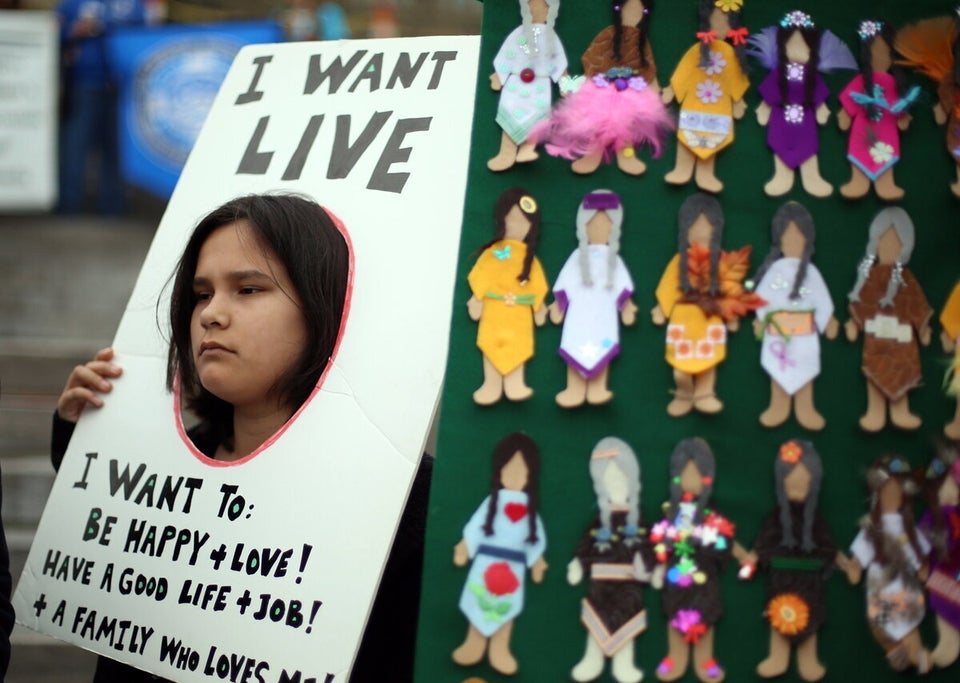Half a skull, and an anklebone -- that's all that remains to tell us she ever lived. Nineteen years after a roadside souvenir vendor found her skull fragment in a ditch near Mission, B.C., and 11 years after police matched her skull's DNA with an anklebone found on the farm of notorious serial killer Robert Pickton, she has yet to be identified. Without a name there will never be a family to notify. She will have no grave -- just a box in a police evidence locker.
It's the victims without names that haunt Maryanne Pearce. The 42-year-old Ottawa mother and federal government worker has devoted seven years to documenting missing and murdered women in Canada, building what may be Canada's most comprehensive database of these cases. Through her research, Pearce has discovered that the number of missing and murdered aboriginal women in Canada is higher than anyone ever realized.
The Native Women's Association of Canada's Sisters in Spirit project has documented 582 cases of missing and murdered aboriginal women from approximately 1990 until the federal government cut funding to the project in 2010. With three more years of cases in her database, and intensive research, Pearce has documented 824 cases.
As with the residential school tragedy, where the Truth and Reconciliation Commission just raised the estimated death toll of aboriginal children in residential schools to more than 4,000, the more researchers like Pearce dig, the more it becomes apparent just how immense the problem is.
In 2006, the trial of Robert Pickton began. Pearce watched with mounting horror as ever more gruesome details emerged -- both about the crime, and the difficulties and failures of the police in solving it. "I just couldn't stand still," she told us.
Pearce focussed her doctoral degree in law at the University of Ottawa on investigating why women--especially aboriginal women--are more vulnerable to violent predators like Pickton, and why so many of their disappearances go unsolved. In September, she finished her thesis, An Awkward Silence: Missing and Murdered Vulnerable Women and the Canadian Justice System.
At the core of Pearce's work is her database. She has meticulously documented 3,329 missing and murdered aboriginal and non-aboriginal women using public sources like newspaper articles, web sites, public police files, and missing person posters. Some of the cases date back to the 1950s, but the overwhelming majority are from 1990 to 2013.
In each case, Pearce noted key factors in the victims' lives, such as homelessness, addiction, mental illness, involvement in the child welfare system or sex trade. These factors appear in a significant number of the cases in her database, and Pearce says they play a role in making women more vulnerable to violent predators.
Where possible, Pearce also recorded the ethnicity of the victim. She discovered another risk factor: simply being an aboriginal woman. Of all the missing and murdered women in the database, 24.8 per cent are aboriginal, even though aboriginal women make up only about two per cent of the Canadian population.
Canada's missing and murdered aboriginal women have drawn international attention. Last year, the United Nations' review of Canada's human rights record echoed the plea of Canadian aboriginal organizations to hold a national inquiry. While Pearce does not oppose a national inquiry, she worries it would result in yet another report gathering dust on a shelf.
"I would like to see more action and less inquiry," she said, noting there are already recommendations waiting to be implemented, such as those of the Missing Women Commission that followed the Pickton trial.
According to Pearce, what is most needed to solve cases of missing and murdered women, and protect others from becoming victims, is information. Canada is long overdue in setting up a national DNA database for missing persons and unidentified human remains, she says. Canadian police forces need to better share information with the public that could help break cases and find missing women. And many smaller Canadian police detachments need better training in handling missing persons cases, learning to spot the clues that point to foul play.
Pearce plans to make all of her data available to everyone in order to provide evidence-based recommendations that will help Canada's justice system solve these cases, and protect vulnerable women.
Although her thesis is finished, 3,000 horror stories have taken their toll. Pearce has written the word "murder" so often, she wakes in the night to find her fingers going through the motions of typing it out. When friends talk of visiting other cities, all she can think of are the names of the women who vanished and died there.
All Canadians should share Pearce's horror. The crisis of missing and murdered women is a gaping wound on our nation that must be healed. No one should end up as anonymous bits of bones in a police archive.
ALSO ON HUFFPOST:
